Cable exercises are a great way to add variety to your shoulder workout routine.
It is a great way to build strength and shape the delt muscles, because it has adjustable weight for resistance and different handle attachments, such as single handles, bars, or rope attachments.
You can target all three major deltoid muscles with them: the anterior, lateral, and posterior deltoid.
- For the front delt: cable shoulder presses, cable front raises, and single-arm cable front raises.
- For lateral delt: lateral raise, one arm cable lateral raise
- The rear delt: bent-over cable lateral raise, face pull, and reverse cable crossover.
- The trap muscles: cable shrug and cable upright row.
In this guide, I’m sharing the 12 most effective cable shoulder exercises that have helped my clients build 3d delts.
The best part? You can implement these today, regardless of your experience level.
Discover your body fat percentage and achieve your fitness goals with ease! Check out our body fat calculation

- 12 Best Cable Shoulder Exercises To Build Delt Size
- 1. Cable Shoulder Press
- 2. Cable Front Raise
- 3. Cable Lateral Raise
- 4. Cable Upright Row
- 5. Cable Machine Y Raise
- 6. Bent Over Cable Lateral Raise
- 7. Reverse Cable Crossover
- 8. Face Pull
- 9. Cable Twisting Overhead Press
- 10. Cable Shrug
- 11. High Cable Delt Row
- 12. One-Arm Bent Over Cable Raise
- How To Build Shoulders with a Cable Machine
- Beginner Cable Shoulder Workout Plan
- Intermediate Cable Workout Plan
- Advance Cable Only Workout Plan
- FAQs
- Are cable exercises good for the shoulders?
- Can cable shoulder exercises replace free weight exercises?
- Can cable shoulder exercises help with shoulder pain?
- Conclusion
12 Best Cable Shoulder Exercises To Build Delt Size
Try this cable rope shoulder workout for a few weeks to give your shoulder joints a break from free weights while still challenging your muscles and forcing them to grow.
1. Cable Shoulder Press
If you’re looking for straightforward cable machine shoulder exercises to add to your routine, the cable shoulder press is a great staple exercise to get you started.
It is a variation of the shoulder or overhead press, and it’s one of the best exercises for building size and strength.
Even though you might not see many people using the cable machine for shoulder presses, mixing in your shoulder workout is a fantastic exercise for extra variety.
A study has shown that cable machines increased muscle activation, and RO help recruit new muscle fiber.
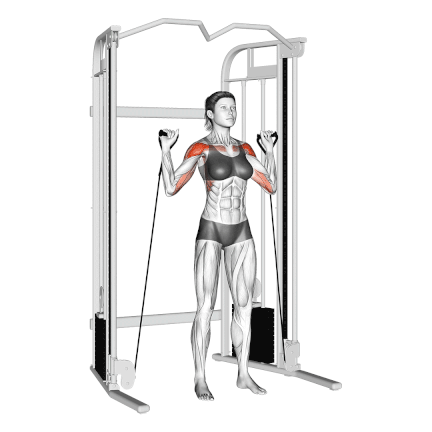
How To Do
- Stand between a low pulley cable machine with two cables attached to the machine.
- Try to stand as close to the cable machine as possible. If you stand too far away, the weight will pull you back, placing stress on your lower back and making the exercise more difficult.
- Grasp the handles with an overhand grip (palms forward) or a neutral grip (palms facing each other).
- Keep your back straight, head up, and chest up, and extend through your elbows.
- Push the handles up towards the ceiling over your head.
- Briefly pause at the top, squeezing your deltoids.
- Inhale slowly, under control, and lower the handles back to the starting position at shoulder height.
2. Cable Front Raise
It is an isolation exercise that athletes and regular gym goers primarily perform for improved size and strength in the anterior deltoid muscle group.
You can also perform the cable front raise using a rope attachment or a single stirrup, one arm at a time.

How To Do
- Attach a straight bar to a low cable pulley. Grab the bar using a shoulder-width or wider overhand grip.
- Take a small step forward away from the machine to create initial tension on the cable.
- Smoothly raise the handle forward and upwards in an arc until the bar is at shoulder height. The movement should come from your shoulder, not swinging your torso.
- Briefly hold at the top, really squeezing your front deltoid.
- Slowly lower the bar back to the starting position,
3. Cable Lateral Raise
This isn’t just another exercise; it’s arguably one of the most effective ways to directly target your medial (lateral) deltoid, the muscle responsible for that rounded, cannonball look from the side.
As a trainer, I program this regularly for my clients because the cable variation offers unique advantages over dumbbells that are hard to beat for pure side delt isolation.
Multiple variations of the lateral raise exist, but they all have the same goal: to build the lateral delts.
The one-arm cable lateral raise is an isolated shoulder exercise that targets the deltoids while increasing stability in both the wrists and the core.
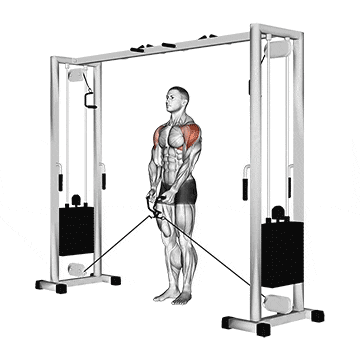
How To Do
- Attach single-grip handles to the lowest point of the cable pulley system.
- You should begin with a lighter weight to achieve optimal performance.
- The handle from the right pulley should be in your left hand, and the handle from the left pulley should be in your right hand. The cables should be crossed and pulled tightly.
- Exhale and gently raise the handle outwards to the side in an arc. Keep the slight bend in your elbow constant. Lead the movement slightly with your elbow, as if you’re pouring a pitcher of water. Do not shrug your shoulders.
- Focus on lifting with the side of your shoulder. Raise the handle until your arm is roughly parallel to the floor, or slightly above shoulder height if comfortable and controlled.
- Briefly pause at the top, really squeezing your lateral deltoid.
- Slowly lower the handle back to the starting position. Resist the pull of the cable for 2-3 seconds.
4. Cable Upright Row
The cable upright row is effective for hitting the upper traps and side delts, but it demands respect and precise form due to its potential for shoulder irritation if done incorrectly
The study found that using a wider grip during the upright row exercise significantly increases the lateral and posterior deltoids recruitment and the upper and middle trapezius muscles.
Note: It is undoubtedly an effective exercise for targeting the deltoid, but due to its biomechanics (internal rotation with high elevation), it carries a risk of subacromial impingement. This risk can be reduced by limiting the height at which the bar is pulled (elbows don’t go above shoulder height) and the grip width (Use a wide grip).
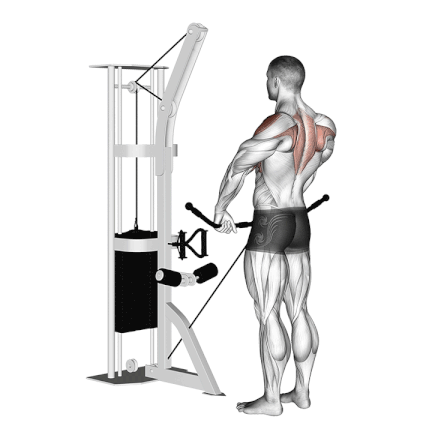
How To Do
- Attach a straight bar to a low cable pulley.
- Grasp the attachment with an overhand grip (palms facing your body). Use a grip that is shoulder-width apart or slightly wider, not closer than shoulder-width.
- Step back slightly from the machine to create initial tension on the cable, allowing the weight to hang with your arms extended down.
- Stand tall with your feet shoulder-width apart, knees slightly bent, core braced tightly, chest up, and back straight.
- Exhale and pull the attachment upwards towards your chin or collarbone. Move with your elbows, pulling them up and out to the sides. Keep the bar/rope close to your body as it travels upwards.
- Do not pull the bar or rope higher than your collarbone or chin. Your elbows should be level with or slightly below your shoulders.
- Briefly squeeze your upper traps and the side of your shoulders at the top.
- Inhale and slowly lower the attachment back to its starting position. Resist the cable’s pull; don’t let it drop quickly.
- Do not pull the bar up any higher. Hold for a count of two.
- Inhale as you lower the bar to the starting position.
Know More: Upright Row: Muscle Worked, Form, Benefits, Variations
5. Cable Machine Y Raise
If you’re looking for a way to get more creative with your cable shoulder workout, why not try cable Y-raise?
The study has shown that this advanced shoulder isolation exercise targets all deltoid fibres, including anterior, lateral, and posterior and lower trap trapezius and supporting scapular stabilisers.
I often program it after heavier pulling or pressing movements, or even as a warm-up set with very light weight to prepare the shoulders for a workout. It’s excellent for postural correction work.
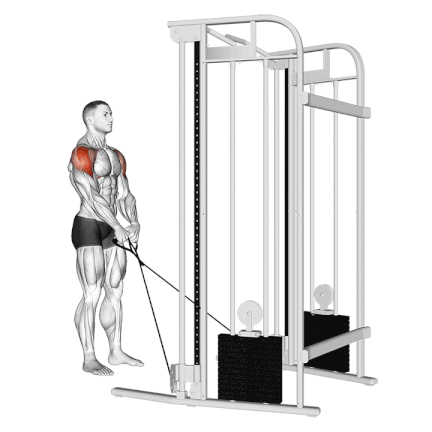
How To Do
- Stand facing between two low cable pulleys, with each hand holding the handle of the cable of the opposite pulley.
- Push your chest forward and point your shoulders back while slightly bending both knees to maintain good posture.
- Stand straight up with your arm fully extended and feet facing forward.
- Exhale and smoothly raise both handles simultaneously upwards and outwards at about a 45-degree angle from your body (forming a “Y” shape).
- Keep your arms relatively straight but with that soft elbow bend. Do not shrug your shoulders excessively. Focus on lifting with the back of your shoulders and lower traps.
- Hold for a second, and then slowly lower the handles back down to the starting position along the same diagonal path.
6. Bent Over Cable Lateral Raise
The rear deltoids are often the shoulder girdle’s weakest and most underdeveloped part. However, they are crucial for a 3d shoulder look, improving posture, and overall strength.
A bent-over cable raise is an excellent exercise for training and isolating the rear deltoid muscle.
The main action is Shoulder Horizontal Abduction (moving your arm away from the midline of your body in a plane roughly parallel to the floor). There is also significant Scapular Retraction (drawing the shoulder blades towards the spine).
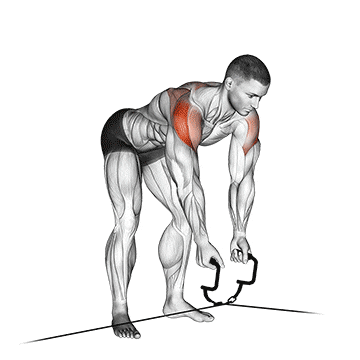
How To Do
- Attach single-grip handles to each cable.
- Grasp the handle in the opposite hand (e.g., left hand grasps the right cable handle, right hand grasps the left cable handle). Your arms will be crossed in front of you.
- Step back slightly from the machine to create initial tension on the cables.
- Bend forward at the waist with your back straight and parallel to the floor. Your torso should be roughly parallel to the floor or slightly higher (e.g., 45-90 degrees).
- Exhale and smoothly raise both handles simultaneously outwards and slightly backwards in an arc.
- Raise the handles until your arms are roughly parallel to the floor in the bent-over position, forming a “T” shape with your torso. Do not shrug or use momentum.
- Lower the handles back down to the start position, your right hand directly in front of the left ankle and your left hand in front of the right ankle.
7. Reverse Cable Crossover
This exercise provides a unique feel and tension that complements bent-over variations. The Reverse Cable Crossover helps you to strengthen and tone the rear deltoid muscles.
It is a very effective and functional exercise for building muscle and strength in the posterior deltoids. Additionally, it helps to improve shoulder stability and posture.

How To Do
- Stand facing away from a cable crossover machine.
- Set both pulleys high, typically above shoulder height. Attach single-grip handles to each cable.
- Reach back and grasp the handle in the opposite hand (e.g., left hand grasps the right cable handle, right hand grasps the left cable handle).
- Step forward away from the machine until there is tension on the cables and your arms are extended forward and crossed over in front of you, with a slight, soft bend in the elbows
- Start with hands crossed in front of you at shoulder height, with the left hand holding the left cable and the right hand holding the right cable.
- Exhale and smoothly pull both handles simultaneously outwards and backwards in an arc.
- Slowly allow the handles to return to the starting position.
8. Face Pull
Face pull primarily targets the rear deltoid and, to a lesser degree, also targets the trap, biceps, and triceps.
The high pulley angle is ideal for pulling the weight towards your face in a controlled manner.
Consciously squeeze your shoulder blades together (retraction) as you pull back and let them move naturally forwards (protraction) on the return.
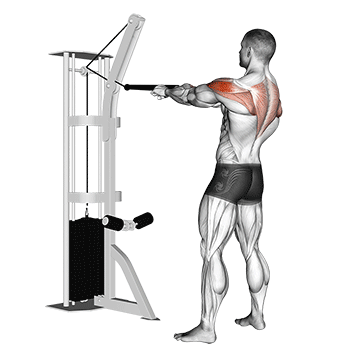
How To Do
- Stand straight with your feet in a comfortable, balanced stance.
- Grab the ends of the rope attachment using a neutral grip (palms facing each other) and slightly lean back.
- Pull the rope toward your face as you spread the ends so they end up on the sides of your ears just above your shoulders in the finish position.
- Think about trying to pinch your shoulder blades as tight as possible when pulling weight toward your face.
- Hold this position for a second as you squeeze your shoulder blades together, contracting rear delts and middle traps as hard as possible.
- Then, slowly return the rope to the start position and repeat for reps.
9. Cable Twisting Overhead Press
The cable twisting overhead press is another effective single-arm cable shoulder exercise. It is a very effective shoulder press variation that works the anterior delt.
It’s a pretty simple exercise, and anyone can do it effectively, making it ideal for size and strength gains.
It is brilliant for developing unilateral upper-body strength, improving balance, and strengthening and stabilising the core.

How To Do
- Attach a stirrup (handle) to a low or waist-high pulley. Grasp the stirrup with one hand.
- Spread your legs and squat a little, keeping your torso upright.
- Position the stirrup to the side of your body, with your elbow flexed and tucked into your side.
- Exhale as you straighten your legs, twist your body, and press the stirrup diagonally upward and away from the pulley.
- Hold for a count of two. Inhale as you reverse the motion and return your body and the stirrup to the starting position.
- Complete the desired number of reps with your right arm.
- Repeat the exercise with your opposite arm.
Related Post: Best Cable Trap Exercises For Strength & Size
10. Cable Shrug
Building thick, strong traps contributes massively to the look of power and size, improves neck stability, and complements your shoulder development.
Cable shrugging is one of the best exercises for training the upper trap. The primary action is Scapular Elevation – simply lifting your shoulder blades straight up towards your ears.
You’ll often see people roll their shoulders forward or backwards during shrugs. Biomechanically, the upper traps’ primary function is elevation. Rolling involves movements from the rhomboids and other trap fibres (retraction/protraction), which put undue stress on the shoulder joint.
There are many ways to do it; here are some of the best variations:
- Straight Bar Cable Shrug
- Single Arm Cable Shrug
- Behind the Back Cable Shrug.
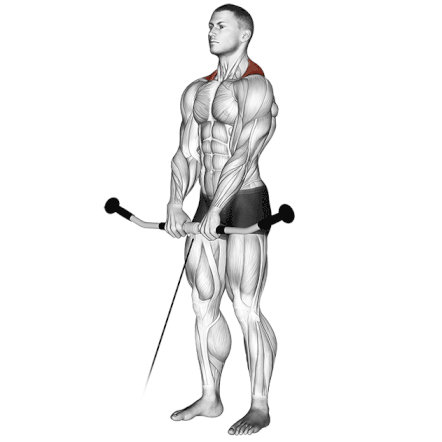
How To Do
- Stand facing a low pulley cable machine.
- Attach a straight bar or two single-grip handles.
- Grasp the attachment with an overhand grip (palms facing your body if using a bar, palms facing in if using handles).
- Your hands should be shoulder-width apart or slightly wider if you wish.
- Stand close to the pulley and extend your arms in front of you while holding the bar.
- Exhale and shrug your shoulders straight upwards towards your ears. Focus on lifting the weight using only your traps. Keep your arms straight and avoid bending your elbows or using your biceps to pull.
- Inhale and slowly lower the weight back down to the starting position. Allow your shoulders to be pulled down fully.
Read More To Know More: Shrug Exercise: Benefits, Variations, Muscles Used, Tips
11. High Cable Delt Row
This exercise is a fantastic tool for building thickness in your upper back (rhomboids and traps) and adding significant size and strength to your rear delts.
In addition, cable rowing effectively compensates for poor posture and shoulder dysfunction.
I typically program the Cable High Row as an accessory exercise on back or shoulder day, often after heavier compound pulling movements (like pulldowns or shoulder press).

How To Do
- Sit facing a cable machine with the pulley set high (above shoulder height when kneeling).
- Grab the rope with both hands using an overhand grip.
- Then, take a step back and get onto your knees, facing the cable machine.
- Exhale and pull the rope towards your upper chest or collarbone. Keep your elbows roughly in line with your shoulders or slightly higher
- Briefly pause at the point of maximal contraction, feeling a strong squeeze between your shoulder blades and in your rear delts.
- Inhale and slowly allow the attachment to return to its starting position.
12. One-Arm Bent Over Cable Raise
This variation is great for working out strength imbalances between your left and right sides and increases the demand on your core stabilizers.
Start with your weaker side first. If you can do more reps or weight with your dominant side, match the reps and weight you used for your weaker side. This helps the lagging side catch up.
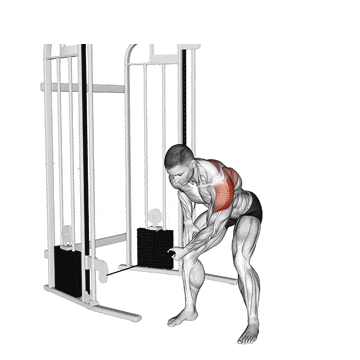
How To Do
- Stand sideways to a low pulley cable machine. Attach a single-grip handle to the cable.
- Grasp the handle with the hand farthest from the machine (e.g., if the cable is on your right, use your left hand).
- Bend over from your hips and your torso should be roughly parallel to the floor, or slightly higher (e.g., 45-90 degrees).
- Let your working arm hang down naturally, crossed in front of you, with a slight bend in the elbow that remains constant.
- Use your non-working hand to support yourself. Rest it on your bent knee or hip.
- Exhale and smoothly raise the handle outwards and slightly backwards in an arc.
- Pause for a moment at the top of the motion before slowly lowering the weight back down to the starting position.
- Repeat with the other arm.
How To Build Shoulders with a Cable Machine
To structure an effective shoulder workout with a cable machine to increase mass and strength, the number of reps and sets will vary based on your fitness level, weekly workout frequency, and strength training goals.
- For strength gains, do 4 to 6 sets of 1 to 6 reps for each exercise with a weight that is at least 85% of your one-repetition maximum (1RM). The fewer reps you perform, the closer to 100% of your 1RM you should strive for.
- If your goal is hypertrophy (muscle growth), perform three sets of each exercise, using loads that are 70 to 85% of your 1RM for 8 to 12 reps.
- When training for endurance, it is usually recommended to use higher reps (15 to 20 repetitions) and moderate loads, with a weight that is at least 50 to 70% of your 1RM.
Beginner Cable Shoulder Workout Plan
| Exercise | Sets | Sets x Reps | Rest |
|---|---|---|---|
| Standing Cable Shoulder Press | 3-4 | 10-12 | 90s |
| Front Cable raise | 3-4 | 12-15 | 90s |
| Cable Rear Delt Flys | 3 | 12-15 | 90s |
Intermediate Cable Workout Plan
| Exercise | Sets | x Reps | Rest |
|---|---|---|---|
| Cable Twisting Overhead Press | 3-4 | 8-10 | 60s |
| Cable Lateral Raises | 3-4 | 10-12 | 60s |
| Cable Face Pulls | 3 | 10-12 | 60s |
| Upright Row | 3 | 10-12 | 60s |
Advance Cable Only Workout Plan
| Exercise | Sets | Sets x Reps | Rest |
|---|---|---|---|
| Cable Shoulder Press | 4 | 8-10 | 60s |
| One Arm Cable Lateral Raise | 4 | 10-12 | 60s |
| Cable Reverse Flys | 4 | 10-12 | 60s |
| Cable Face Pulls | 3-4 | 12-15 | 60s |
| Cable Shrug | 3-4 | 10-12 | 60s |
FAQs
Are cable exercises good for the shoulders?
Yes, cable rope shoulder exercises are a great way to build strong, powerful shoulders. Using the cable machine, you can hit all three deltoids from different angles and through a range of motions.
You can also change body positioning, weight load, and attachments used, altering your grip and targeting your muscles differently.
Can cable shoulder exercises replace free weight exercises?
Cable shoulder exercises can be helpful, but they shouldn’t be used as a replacement for free-weight exercises. It should be a part of a complete shoulder workout routine.
Can cable shoulder exercises help with shoulder pain?
Cable shoulder exercises can help strengthen and stabilize the shoulder muscles, which may help reduce the risk of shoulder pain and injuries.
However, if you are currently experiencing shoulder pain or injury, it is important to consult with a medical professional before beginning any new exercise program.
Conclusion
A cable shoulder Workout is highly recommended for anyone interested in building a wider shoulder and who wants to gain strength.
Shoulder exercises on a cable machine can hit your shoulders from all angles, stimulating new muscle fibers to be activated for potential growth.
If you incorporate these cable shoulder exercises into your workout regimen and do them consistently, the results will speak for themselves. They allow for targeted muscle development and provide an overall 3D look to the shoulder.
Thanks for reading. Enjoy your Workout.
References
- Campos YAC, Vianna JM, Guimarães MP, Oliveira JLD, Hernández-Mosqueira C, da Silva SF, Marchetti PH. Different Shoulder Exercises Affect the Activation of Deltoid Portions in Resistance-Trained Individuals. J Hum Kinet. 2020 Oct;75:5-14. doi: 10.2478/hukin-2020-0033. PMID: 33312291; PMCID: PMC7706677.
- Botton C, Wilhelm E, Ughini C, Pinto R, Lima C. Electromyographical analysis of the deltoid between different strength training exercises. Med Sport. 2013;17:67–71
- https://www.acefitness.org/continuing-education/prosource/september-2014/4972/dynamite-delts-ace-research-identifies-top-shoulder-exercises/

Manish is a NASM-certified fitness and nutrition coach with over 10 years of experience in weight lifting and fat loss fitness coaching. He specializes in gym-based training and has a lot of knowledge about exercise, lifting technique, biomechanics, and more.
Through “Fit Life Regime,” he generously shares the insights he’s gained over a decade in the field. His goal is to equip others with the knowledge to start their own fitness journey.
